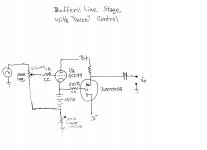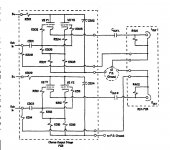PAIA-ELECTRONICS 9407 TUBE-MIC-PREAMP SCH. Service Manual download, schematics, eeprom, repair info for electronics expertsWow ... 5 pages? I guessed this was probably a very covered subject. I should maybe give a touch more information. I already own a Topping preamp and Dac90. Good solid state units, known for extreme transparency, with little coloration. I just wanted to play with some tube coloration a bit. I'm NOT trying to improve my sound quality. Just have some flavor choices. I do not need gain. Just wanted to do a bit of inexpensive tube rolling. I know I could buy a tube preamp, amp, or even DAC. But that isn't what I wanted exactly. I just wanted to experiment some.
The inside shot looks like a liability lawsuit waiting to happen (I can't see any filtering, fuses etc).. not to mention internet sales are, by law in the EU/UK, a 14 day return no quibble.. lastly I like the 'username: Bottlehead' just to trigger all the right associations and search-engine hit responses..
Indeed, and both photos are of something different.
Notice no power switch on the underside view.
The power connector is in a different position, etc.
That so-called company is just a dumb scam outfit.
They've been around for decades, and charging such rediculous prices for something like that..... thing....... is pure snake oil, as is all their other products.
Hi Eli - what practical circuit and devices would comprise your anode-follower's CCS and what would be the B+? What happens to the harmonic structure w. CCS vs a resistor plate load? For higher Z would a 12AU7 work? Could a paper cap help flavor things further?
Hi Eli - what practical circuit and devices would comprise your anode-follower's CCS and what would be the B+? What happens to the harmonic structure w. CCS vs a resistor plate load? For higher Z would a 12AU7 work? Could a paper cap help flavor things further?
Any number of cascode CCS circuits can be found in the archives. The "El Cheapo" schematic shows DN2540 FETs and would work. K&K Audio offers useful CCS kits.
The 12B4 circuit I provided is a common cathode gain block built around a low μ triode. An anode follower employs short loop plate to grid NFB. The O/P stage found in the Harman-Kardon Citation I preamp is an anode follower.
A 150 V. rail is quite adequate for the 12B4 setup.
The 12AU7 is not suited to this application. It's non-linear, has too much gain, and its plate resistance is far too large. The extremely low plate resistance of the 12B4 is what allows the type to drive awkward loads, when wired common cathode.
Last edited:
After getting into DiY years ago and joining many forums, one thing became very clear: listen to Eli Duttman.
FWIW, an old idea worked its way out of my memory. I toyed with the idea of a buffered volume control that could function as an effects machine, when that was desired.
Any member that wants to develop the concept has my blessing. The ZVP0545A FET shown is the "P" channel complement to the ZVN0545A I and other members successfully exploit.
Any member that wants to develop the concept has my blessing. The ZVP0545A FET shown is the "P" channel complement to the ZVN0545A I and other members successfully exploit.
Attachments
AThe 12AU7 is not suited to this application. It's non-linear, has too much gain, and its plate resistance is far too large. The extremely low plate resistance of the 12B4 is what allows the type to drive awkward loads, when wired common cathode.
Nice little tube that - single triode for driving low current which is similar to the 12BH7A (double triodes) so I assume that the 12B4 is the single version of the 12BH7A (the 4 to 7 being the internal active elements) so B to BH? (edit: BH4 has lower mu than the BH7A.. so that's probably not such a good thing.)
Last edited:
Lukasz Fikus ("the Lampizator") started his "CD players' output tube stage saga" a long time ago,mainly because of the frustrations generated by the opamp output stages (the ones immediately following after the DAC chip).There's the LampizatOr guy from Poland who took the idea of adding a "lamp" (tube) into a CD player output many years ago
His work and ideas created a whole movement in DIY world by modding those medium-to expensive players and squeezing the most of them...with tube outputs. 😀
In the same period,there was a controversial article published in the "Sound Practice" magazine written by Mike Vans Evers and named "The Chorus".You guessed right,the same idea ("how to makeup an Audio Alchemy DITB converter by modding it's output stages"),but this time,gone even further:a parallel CF with DIFFERENT TYPE of tubes.
At the time,I made some such "choruses" (with a better HV supply,though,everything packed in the form of a separate "line preamp" unit) for some friends who were curious and willing to test this weirdo in their systems.Each of them kept the "Chorus" PCB until they seriously upgraded their respective systems.The overall impression was that the differences were hearable enough to be considered and a few pairs of tubes to play with were cheaper to "tune with" as compared to some expensive,mumbo-jumbo cables or other gimmics.
I'm not an expert by any means (and still a weaker theoretician)...please,could somebody qualified explain what's going on with this?
Thanks! 🙂
Attachments
I love the OP's inquiry. It's about time someone who admits wanting some harmonic distortion. At least he knows what he wants. In the recording world, most engineers openly want flavors or colors in their sound without feeling heretical. I personally want some colors in the sound and okay with deviating from neutrality. For me most so-called "neutral" gears are boring sounding. And this obsession with purity is a straitjacket to me. I just wish the audiophile magazines can just be honest about liking distortion and not having to apologize for it so we would not have the divisive camps into the subjectivists and objectives. It's okay to use objective means to achieve subjective end. It's a freaking hobby! I hope OP finds what he's looking for. I'm paying attention.
You'll need a DAC to get music out of your PC over to your new amplifiers, so might as well pick one with a tube buffer.
you mean like this one ?
Surface Standard Console Stereo Amplifier - YouTube
Yeah, like that one. Put an 8-16 ohm resistive load on it, pad it down to line level with a couple more resistors - it'll drive that 7k input impedance of those big SS amps no problem.
I had an Aune T1 USB DAC (had to dig for that) which has a discrete FET based headphone amp after a tube buffer. I guess it was popular a while back for tube rolling, as it would work with a wide range of tubes, including those people would make pin adapters for, like 6SN7s...
I tried these Ampex BugalBoys in it, but they were made for car radio and 25V on the plate. They worked and sounded different than the "Gold Lion" accessory tube the previous owner had bought for it. You could pop a different tube into it while it was playing and you'd only have to wait for the heater in the fresh one to come up!
I bet someone has a fixture for that, to keep the rolling into tubes heaters hot, so they dont even have to wait! How about such a product with two tube sockets and a big red switch?
I had an Aune T1 USB DAC (had to dig for that) which has a discrete FET based headphone amp after a tube buffer. I guess it was popular a while back for tube rolling, as it would work with a wide range of tubes, including those people would make pin adapters for, like 6SN7s...
I tried these Ampex BugalBoys in it, but they were made for car radio and 25V on the plate. They worked and sounded different than the "Gold Lion" accessory tube the previous owner had bought for it. You could pop a different tube into it while it was playing and you'd only have to wait for the heater in the fresh one to come up!
I bet someone has a fixture for that, to keep the rolling into tubes heaters hot, so they dont even have to wait! How about such a product with two tube sockets and a big red switch?
You could pop a different tube into it while it was playing and you'd only have to wait for the heater in the fresh one to come up!
I bet someone has a fixture for that, to keep the rolling into tubes heaters hot, so they dont even have to wait! How about such a product with two tube sockets and a big red switch?
Oh good lord...... to have to wait for a 15 second eternity!
The inconvenience!...... the hassle!
It reminds me of the 1960's tube type TV sets, with "insta-on" circuits that kept the heaters slightly "on" so the sound/picture would come on fast.
And the advertising of stereos, phonos.... "cool-running Solid State circuitry!..... instant sound, no tubes to wear out!
Marketing - bleh.... it's all about manipulating the public with just another gadget/product/idea/drug/etc.
Having tested a box of 100 of 12AT7WA, Brimar and Mullard manafacture, I wonder what is the point of tube rolling. Unless you can analyse all of the tubes qualitatively you intend to roll, so they have equivalent characteristics (on both halves, if applicable), then what are you rolling?
The tubes I tested were spread over a very wide range of tolerances. The advantage of having 100 was that I could group them together with similar curves, and those that were not similar could be catergorised for roles where this was not important (e.g. driver/splitter).
The tubes I tested were spread over a very wide range of tolerances. The advantage of having 100 was that I could group them together with similar curves, and those that were not similar could be catergorised for roles where this was not important (e.g. driver/splitter).
Sound is bad, very musty.😱
You know that with my old Mercedes Diesel every time before starting I'd have to wait the famous Rudolf Diesel remembrance minute for glowing of the glow candles. But once it was running, that car would have driven around the world with this engine and never failed. Never! Thats the difference to todays products.Oh good lord...... to have to wait for a 15 second eternity!
The inconvenience!...... the hassle!
"I bet someone has a fixture for that, to keep the rolling into tubes heaters hot, so they dont even have to wait! How about such a product with two tube sockets and a big red switch?"
its been done, Blackie Pagano had such amp at NY noise show
its been done, Blackie Pagano had such amp at NY noise show
Sound is bad, very musty.😱
was recorded with iPhone XR. Live sound is very nice.
the recording more to demonstrate how to get a few watts of audio power with just a couple of power tubes, from a headphone jack.
I really don't know if I want to spend the $150 dollars for an expensive iPhone external stereo mic......
- Home
- Amplifiers
- Tubes / Valves
- How to "add tube sound" to a system


